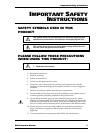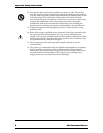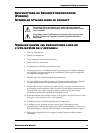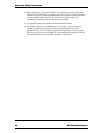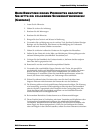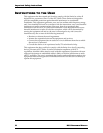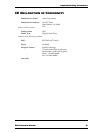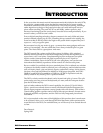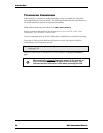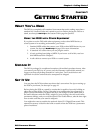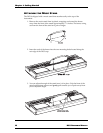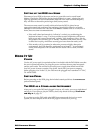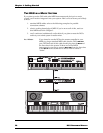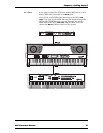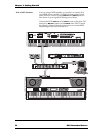
Introduction
DG8 REFERENCE MANUAL 15
INTRODUCTION
In the years since electronic musical instruments made their debut in the early 1970s,
the quest for a transportable piano that had the sound and feel of a true acoustic
instrument seemed to elude every manufacturer. They tried everything, including a
rather ingenious re-design of the grand piano that you could take apart into two
pieces when travelling. The trade-off? It was still bulky, rather expensive, and
because it had strings (just like a real piano) it needed to be tuned periodically. If you
moved it often, you had to tune it often.
Even as digital sampling technology began to mature in the early 1990s and piano
products started popping up all over, something always seemed to be missing: the
sound was thin or the keys didn’t feel right or the pedals didn’t respond like you’d
expect or... well, you get the point.
But no matter how big my music rig gets – no matter how many gadgets and boxes
and toys I accumulate – the one sound that I have always insisted upon is a great
piano. The Alesis DG8 is a great piano. And more.
The DG8 sounds like a piano and feels like a piano. Its 88-key, fully-weighted,
hammer-action keyboard is an advanced design that provides the response you’d
expect from, well, a real piano. Complementing its piano realism are four pedal
inputs: sustain/sostenuto and soft pedal expression plus an AUX jack for
volume/modulation. Factor in the DG8’s 64-voice polyphony, and you have an
instrument that faithfully reproduces all the nuances of a fine acoustic piano.
But we wouldn’t be satisfied with just a standard piano. We’ve tailored our selection
of pianos to be ideally suited for classical, jazz, rock and pop, and included an entire
suite of electric pianos, pipe and electric organs, synthesizers, strings, choirs, basses,
clavinets, vibes and harpsichord. In addition to its 88 preset programs, the DG8’s
24MB of sound ROM is expandable to 32MB via a PCMCIA expansion card slot,
ideally suited for any Alesis QCard
TM
expansion module.
The DG8’s velocity-sensitive keyboard can be layered and split, of course. The split
point can be set to any point on the keyboard you want, and the Transpose feature
puts the DG8 into any key.
And to further enhance the DG8’s sound capability, the Alesis QS Parallel Matrix
Effects
TM
provide reverb and chorus on nearly all internal Keyboard Programs (the
electric organ programs substitute a rotary speaker effect for chorus). Add to that a
5-band analog graphic equalizer and a built-in 100-watt-per-channel, discrete stereo
bi-amped amplifier and speakers, and the DG8 is a fully-integrated powerhouse
instrument.
We’ve just touched on the some of the highlights of this product; there’s much more
to be explored. After you’ve read through this brief document, and experienced the
sound and feel of the DG8, I’m confident that you will be every bit as excited about it
as I am.
Dave Bertovic
Spring 1999



